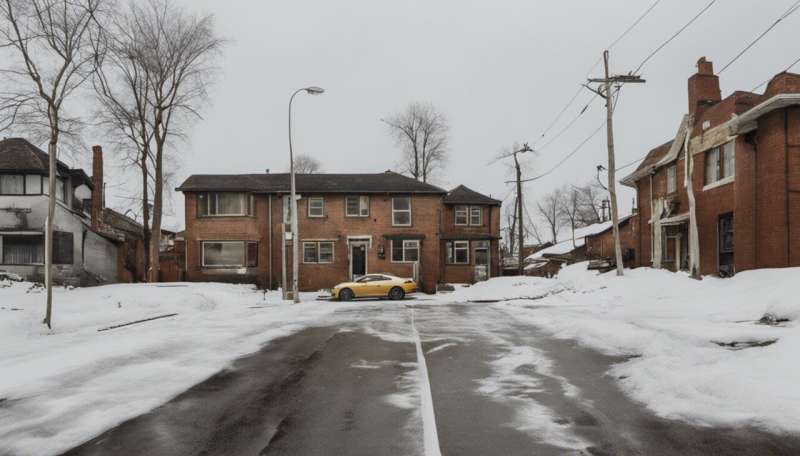This article has been reviewed according to Science X's editorial process and policies. Editors have highlighted the following attributes while ensuring the content's credibility:
fact-checked
trusted source
written by researcher(s)
proofread
Are low-traffic neighborhoods greenwashing? Here's what the evidence says

Since the pandemic, a series of low-traffic neighborhoods (LTNs) have been installed across the UK. LTNs are designed to curtail car use in residential streets and promote active modes of travel such as walking, cycling and traveling by wheelchair. They aim to create a more pleasant environment for pedestrians and cyclists by using cameras, planting boxes or bollards to restrict motor vehicle traffic.
The initiative aims to address three public health issues directly associated with rampant car use in urban areas: air pollution, road deaths and physical inactivity. Human-made air pollution—which is worse in congested cities—is linked to between 28,000 and 36,000 deaths in the UK each year.
The concept of LTNs in the UK can be traced back to the 1970s when a similar scheme (although not referred to as an LTN at the time) was introduced in the London borough of Hackney. Many of the UK's more recent LTNs are concentrated in deprived areas of London, with low rates of car ownership.
By contrast, similar schemes have been more widely adopted in the Netherlands, where active travel has been separated from car traffic consistently since the 1970s.
But LTNs have become controversial in the UK. Critics have even gone as far as accusing the government of greenwashing. They argue that LTNs cause more congestion and air pollution on boundary roads (usually larger roads around the perimeter of an LTN), longer emergency response times and increased travel times for disabled people or caregivers.
Since most LTNs are relatively recent and have been predominantly installed in London, there is limited information on their long-term effects and impacts beyond the capital.
Yet the existing evidence still offers a clearer understanding of how LTNs can positively impact various aspects of urban life.
Fewer cars, more active travel
Some studies suggest that LTNs are effective in reducing car usage. Recent research on four LTNs in the south London borough of Lambeth that was co-authored by one of us (Jamie Furlong), found that the annual distance residents within these LTNs drove decreased by 6% compared to control areas.
This finding supports previous research commissioned by climate action charity, Possible, that examined traffic data from 46 LTNs across 11 London boroughs. The analysis revealed a substantial reduction in motor traffic within LTNs compared to the expected background changes. Importantly, there was no evidence of traffic being systematically displaced onto boundary roads.
A separate study by researchers from Imperial College London on three LTNs in the London borough of Islington showed notable improvements in air quality after their installation. On average, levels of nitrogen dioxide (a harmful car exhaust pollutant) decreased by 5.7% within the LTNs and 8.9% on boundary roads.
LTNs have demonstrated several other benefits beyond reduced car usage. In London, they have even been associated with decreased car ownership and improved road safety. Between 2015 and 2019, rates of car ownership in outer London LTNs reduced by 6% relative to control areas.
Evidence on the shift to active travel prompted by LTNs is more limited. However, a study funded by Transport for London on LTNs that pre-dated COVID in London's Waltham Forest, found a 1–2 hour increase per person in weekly active travel compared to the control area.
What about the concerns?
One criticism of LTNs relates to the potential delays they can cause for emergency services. Videos have surfaced online showing fire engines and ambulances unable to get past bollards or planting boxes.
However, the only published academic study on the topic, which examined the impact of LTNs on fire service emergency response times in Waltham Forest, found no negative effects. In fact, response times even improved slightly on some boundary roads.
Learning from Barcelona
How residents feel about LTNs and their streets is crucial to the success of these schemes. In both Ealing (a district of west London) and Warrington (a town in northern England), councils removed LTNs after the objection of residents.
The fact that relatively few of the UK's more recent LTNs have altered street layouts to encourage new uses by, for example, widening pavements and turning car parking spaces into public seating may be part of the issue. If LTNs were implemented with a stronger focus on urban design and physical changes to the streetscape, they could have a potentially transformative effect on how people feel about and use residential streets.
The "superblocks" initiative (city blocks where pedestrians and cyclists are prioritized over motorized vehicles) in Barcelona is a good example of such an approach. Following the implementation of the city's Sant Antoni superblock, research found a 33% reduction in nitrogen dioxide emissions, an 82% reduction in traffic within the superblock and a 28% increase in public space to walk and play in.
During trial phases, various features were incorporated into Barcelona's neighborhoods, including colored pavements, mobile tree planters and pop-up playgrounds. In the Poblenou superblock, the final design of street changes resulted from two weeks of laboratories and debates involving residents, council officers, political representatives and more than 200 students and teachers from different schools of architecture.
In the UK, the future of LTNs hangs in the balance due to a shaky funding base. But this development is accompanied by a climate emergency that demands swift and decisive action.
Provided by The Conversation
This article is republished from The Conversation under a Creative Commons license. Read the original article.![]()





















